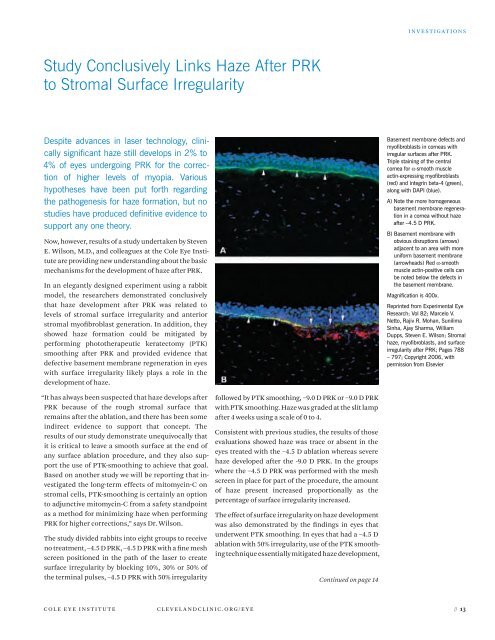Ophthalmology Update - Cleveland Clinic
Ophthalmology Update - Cleveland Clinic
Ophthalmology Update - Cleveland Clinic
You also want an ePaper? Increase the reach of your titles
YUMPU automatically turns print PDFs into web optimized ePapers that Google loves.
Study Conclusively Links Haze After PRK<br />
to Stromal Surface Irregularity<br />
Despite advances in laser technology, clinically<br />
significant haze still develops in 2% to<br />
4% of eyes undergoing PRK for the correction<br />
of higher levels of myopia. Various<br />
hypotheses have been put forth regarding<br />
the pathogenesis for haze formation, but no<br />
studies have produced definitive evidence to<br />
support any one theory.<br />
now, however, results of a study undertaken by steven<br />
e. Wilson, m.d., and colleagues at the cole eye institute<br />
are providing new understanding about the basic<br />
mechanisms for the development of haze after prK.<br />
in an elegantly designed experiment using a rabbit<br />
model, the researchers demonstrated conclusively<br />
that haze development after prK was related to<br />
levels of stromal surface irregularity and anterior<br />
stromal myofibroblast generation. in addition, they<br />
showed haze formation could be mitigated by<br />
performing phototherapeutic keratectomy (ptK)<br />
smoothing after prK and provided evidence that<br />
defective basement membrane regeneration in eyes<br />
with surface irregularity likely plays a role in the<br />
development of haze.<br />
“it has always been suspected that haze develops after<br />
prK because of the rough stromal surface that<br />
remains after the ablation, and there has been some<br />
indirect evidence to support that concept. the<br />
results of our study demonstrate unequivocally that<br />
it is critical to leave a smooth surface at the end of<br />
any surface ablation procedure, and they also support<br />
the use of ptK-smoothing to achieve that goal.<br />
Based on another study we will be reporting that investigated<br />
the long-term effects of mitomycin-c on<br />
stromal cells, ptK-smoothing is certainly an option<br />
to adjunctive mitomycin-c from a safety standpoint<br />
as a method for minimizing haze when performing<br />
prK for higher corrections,” says dr. Wilson.<br />
the study divided rabbits into eight groups to receive<br />
no treatment, –4.5 d prK, –4.5 d prK with a fine mesh<br />
screen positioned in the path of the laser to create<br />
surface irregularity by blocking 10%, 30% or 50% of<br />
followed by ptK smoothing, –9.0 d prK or –9.0 d prK<br />
with ptK smoothing. haze was graded at the slit lamp<br />
after 4 weeks using a scale of 0 to 4.<br />
consistent with previous studies, the results of those<br />
evaluations showed haze was trace or absent in the<br />
eyes treated with the –4.5 d ablation whereas severe<br />
haze developed after the -9.0 d prK. in the groups<br />
where the –4.5 d prK was performed with the mesh<br />
screen in place for part of the procedure, the amount<br />
of haze present increased proportionally as the<br />
percentage of surface irregularity increased.<br />
the effect of surface irregularity on haze development<br />
was also demonstrated by the findings in eyes that<br />
underwent ptK smoothing. in eyes that had a –4.5 d<br />
ablation with 50% irregularity, use of the ptK smoothing<br />
technique essentially mitigated haze development,<br />
the terminal pulses, –4.5 d prK with 50% irregularity Continued on page 14<br />
i n v e s t i g a t i O n s<br />
Basement membrane defects and<br />
myofibroblasts in corneas with<br />
irregular surfaces after PRK.<br />
Triple staining of the central<br />
cornea for α-smooth muscle<br />
actin-expressing myofibroblasts<br />
(red) and integrin beta-4 (green),<br />
along with DAPI (blue).<br />
A) Note the more homogeneous<br />
basement membrane regeneration<br />
in a cornea without haze<br />
after –4.5 D PRK.<br />
B) Basement membrane with<br />
obvious disruptions (arrows)<br />
adjacent to an area with more<br />
uniform basement membrane<br />
(arrowheads) Red α-smooth<br />
muscle actin-positive cells can<br />
be noted below the defects in<br />
the basement membrane.<br />
Magnification is 400x.<br />
Reprinted from Experimental Eye<br />
Research; Vol 82; Marcelo V.<br />
Netto, Rajiv R. Mohan, Sunilima<br />
Sinha, Ajay Sharma, William<br />
Dupps, Steven E. Wilson; Stromal<br />
haze, myofibroblasts, and surface<br />
irregularity after PRK; Pages 788<br />
– 797; Copyright 2006, with<br />
permission from Elsevier<br />
c O l e e y e i n s t i t U t e c l e v e l a n d c l i n i c . O r g / e y e //
















